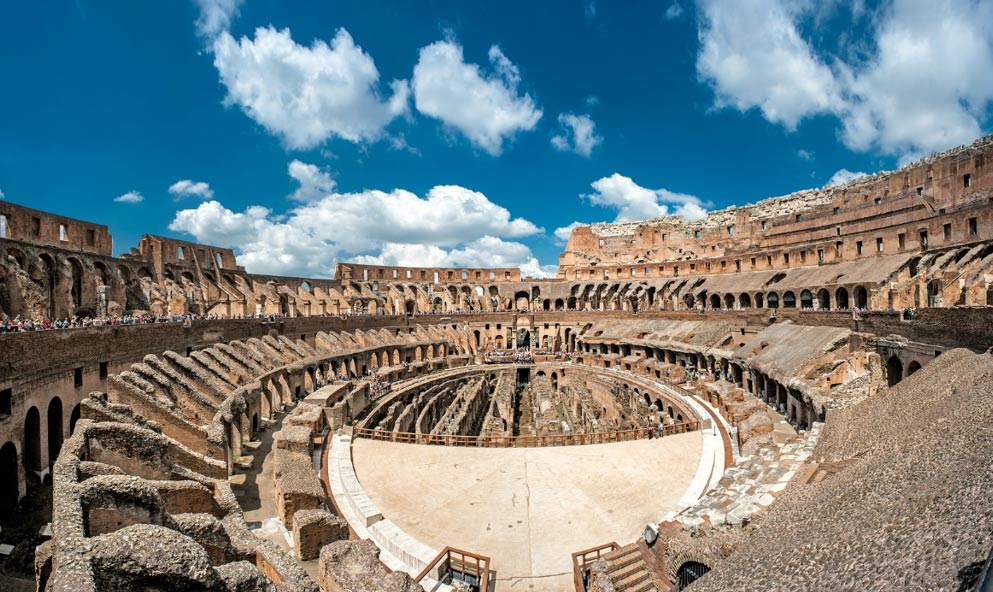(Humans are Free) A team of civil engineers in France have revealed that the Romans had ancient technology for building structures that acted like modern-day electromagnetic cloaking devices.
Related Bizarre CIA Classified Files Released on Lost Ancient Human Civilizations
by Staff Writer, May 12th, 2019
The pattern of foundations in some major Roman monuments, like the Colosseum, provided protection against earthquakes by bending seismic waves around them.
Ancient Archaeological Metamaterials
The Romans used architectural features in their constructions which acted like ‘metamaterials’, artificial structures that can manipulate electromagnetic or sound waves.
Buy Book Forbidden Archeology: The Hidden History of the Human Race
For example, surrounding a building with a lattice of holes or solid objects embedded in the soil can have the effect of diverting seismic waves around the monument, effectively creating a seismic ‘invisibility cloak’.
According to Physics World, “When seismic waves within a certain range of wavelengths pass through the lattice, multiple reflections in the lattice interfere with one another destructively to create a band gap that results in a significant reduction in the shaking of the building.”
Modern-day Metamaterials
Manmade metamaterials were first synthesized in the lab in 2000 by using highly conductive metal like gold or copper in certain arrangements, like layered lattice structures.
They were developed for a variety of uses, including making ‘super lenses’, that are able to see objects at much smaller scales, and reducing the impact of earthquakes on buildings.
ArsTechnica reported that when researchers compared the modern-day metamaterials with the structures of certain Roman monuments, they found that the patterns in ancient Roman buildings very, very closely resembled metamaterials and may therefore have protected those structures from earthquakes.
Stephane Brûlé, a civil engineer and one of the study’s authors, had worked with a team of engineers from Lyon-based company Menard and researchers from the Fresnel Institute in Marseille, a few years ago to create a large-scaled seismic cloak by drilling an array of boreholes in the soil.
Later on, he noticed that a Gallo-Roman theater he visited while on holiday in Autun, France, had the same foundational structure.
Did the Romans already know about the seismic cloaking properties of such an array? It seems likely, as the same pattern was used in the construction of numerous Roman monuments, including many theaters and amphitheaters.
By Joanna Gillan, Ancient-Origins.net (excerpt)
Buy Book Gobekli Tepe: Genesis of the Gods: The Temple of the Watchers and the Discovery of Eden
Stillness in the Storm Editor: Why did we post this?
Several researchers across the world claim to have discovered ancient technology, used by the civilizations of old in ways we can barely comprehend. The preceding information reveals some of this research, making clear that indeed ancient artifacts we normally regard as mundane might have an advanced purpose. This information is important because it helps dispel the false paradigm if progressive technological advancement and highlights that despite our advanced technology, humanity has much to learn. All of this helps to open the mind to new possibilities and mysteries, which is an essential component of a progressively evolving consciousness.
– Justin
Not sure how to make sense of this? Want to learn how to discern like a pro? Read this essential guide to discernment, analysis of claims, and understanding the truth in a world of deception: 4 Key Steps of Discernment – Advanced Truth-Seeking Tools.
Stillness in the Storm Editor’s note: Did you find a spelling error or grammar mistake? Send an email to [email protected], with the error and suggested correction, along with the headline and url. Do you think this article needs an update? Or do you just have some feedback? Send us an email at [email protected]. Thank you for reading.
Source:
http://humansarefree.com/2019/05/romans-had-ancient-tech-for-creating.html


Leave a Reply